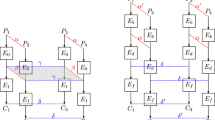Abstract
This paper studies the security of the block ciphers ARIA and Camellia against impossible differential cryptanalysis. Our work improves the best impossible differential cryptanalysis of ARIA and Camellia known so far. The designers of ARIA expected no impossible differentials exist for 4-round ARIA. However, we found some nontrivial 4-round impossible differentials, which may lead to a possible attack on 6-round ARIA. Moreover, we found some nontrivial 8-round impossible differentials for Camellia, whereas only 7-round impossible differentials were previously known. By using the 8-round impossible differentials, we presented an attack on 12-round Camellia without FL/FL 1 layers.
Similar content being viewed by others
References
Daesung Kwon, Jaesung Kim, Sangwoo Park et al. New block cipher: ARIA. In Proc. Information Security and Cryptology (ICISC’03), Seoul, Korea, LNCS 2971, Springer-Verlag, November 27–28, 2003, pp.432–445.
Aoki K, Ichikawa T, Kanda M et al. Specification of Camellia — A 128-bit block cipher. In Proc. Selected Areas in Cryptography (SAC’2000), Waterloo, Canada, LNCS 2012, Springer-Verlag, August 14–15, 2000, pp.183–191.
Lee S, Hong S, Lee S et al. Truncated differential cryptanalysis of Camellia. In Proc. Information Security and Cryptology (ICISC’01), Seoul, Korea, LNCS 2288, Springer-Verlag, December 6–7, 2001, pp.32–38.
Sugita M, Kobara K, Imai H. Security of reduced version of the block cipher Camellia against truncated and impossible differential cryptanalysis. In Proc. Advances in Cryptology (Asiacrypt’01), Queensland, Australia, LNCS 2248, Springer-Verlag, December 9–13, 2001, pp193–207.
Hatano Y, Sekine H, Kaneko T. Higher order differential attack of Camellia (II). In Proc. Selected Areas in Cryptography (SAC’02), Newfoundland, Canada, LNCS 2595, Springer-Verlag, August 15–16, 2002, pp.39–56.
Yeom Y, Park S, Kim I. On the security of Camellia against the square attack. In Proc. Fast Software Encryption (FSE’02), Springer-Verlag, Leuven, Belgium, LNCS 2356, February 4–6, 2002, pp.89–99.
Shirai T. Differential, linear, boomerang and rectangle cryptanalysis of reduced-round Camellia. In Proc. the Third NESSIE Workshop, Munich, Germany, November 6–7, 2002. Available at: https://www.cosic.esat.kuleuven.be/nessie/.
Yeom Y, Park I, Kim I. A study of integral type cryptanalysis on Camellia. In Proc. The 2003 Symposium on Cryptography and Information Security (SCIS’03), Hamamatsu, Japan, January 2003, pp.26–29.
Wenling Wu, Dengguo Feng, Hua Chen. Collision attack and pseudorandomness of reduced-round Camellia. In Proc. Selected Areas in Cryptography (SAC 2004), Waterloo, Canada, LNCS 3357, Springer-Verlag, August 9–10, 2004, pp.256–270.
Duo Lei, Li Chao, Keqin Feng. New observation on Camellia. In Proc. Selected Areas in Cryptography (SAC 2005), Springer-Verlag, Kingston, Canada, LNCS 3897, August 11–12, 2005, pp.51–64.
Wenling Wu. Pseudorandomness of Camellia-like scheme. Journal of Computer Science and Technology, 2006, 21(1): 82–88.
A Biryukov, Christophe De Canniere et al. Security and performance analysis of ARIA. Available at http://homes.esat.kuleuven.be/~abiryuko/ARIA-COSICreport.pdf.
Biham E, Shamir A. Differential Cryptanalysis of the Data Encryption Standard, Springer-Verlag, 1993.
Matsui M. Linear cryptanalysis method for DES cipher. In Proc. Advances in Cryptology–EUROCRYPT’93, Lofthus, Norway, LNCS 765, Springer-Verlag, May 23–27, 1993, pp.386–397.
Knudsen L. Truncated and higher order differentials. In Proc. Fast Software Encryption (FSE’95), Leuven, Belgium, LNCS 2595, Springer-Verlag, December 1994, pp.196–211.
Biham E, Biryukov A, Shamir A. Cryptanalysis of skipjack reduced to 31 rounds using impossible differentials. In Proc. Advances in Cryptology–EUROCRYPT’99, Rague, Czech Republic, LNCS 2595, Springer-Verlag, May 2–6, 1999, pp.12–23.
Biryukov A, Wagner D. Slide attacks. In Proc. Fast Software Encryption (FSE’99), Rome, Italy, LNCS 1636, Springer-Verlag, March 24–26, 1999, pp.245–259.
Biryukov A, Wagner D. Advanced slide attacks. In Proc. Advances in Cryptology–EUROCRYPT’00, Bruges, Belgium, LNCS 1807, Springer-Verlag, May 14–18, 2000, pp.589–606.
Knudsen L, Wagner D. Integral cryptanalysis (extended abstract). In Proc. Fast Software Encryption (FSE 2002), Leuven, Belgium, LNCS 2595, Springer-Verlag, February 4–6, 2002, pp.112–127.
Wagner D. The boomerang attack. In Proc. Fast Software Encryption (FSE’99), Rome, Italy, LNCS 1636, Springer-Verlag, March 24–26, 1999, pp.157–170.
Jakobsen T, Knudsen L. The interpolation attack against block ciphers. In Proc. Fast Software Encryption (FSE’99), Rome, Italy, LNCS 1267, Springer-Verlag, pp.28–40.
Courtois N, Pieprzyk J. Cryptanalysis of block ciphers with overdefined systems of equations. In Proc. Advances in Cryptology–ASIACRYPT’02, Queenstown, New Zealand, LNCS 2595, Springer-Verlag, December 1–5, 2002, pp.267–287.
Jung Hee Cheon, Munju Kim, Kwangjo Kim et al. Improved impossible differential cryptanalysis of Rijndael and Crypton. In Proc. International Conference on Information Security and Cryptology (ICISC’01), Seoul, South Korea, LNCS 2288, Springer-Verlag, December 6–7, 2001, pp.39–49.
Raphael Chung-Wei Phan. Impossible differential cryptanalysis of 7-round AES. Information Processing Letters, 2004, 91(1): 33–38.
Goce Jakimoski, Yvo Desmedt. Related-key differential cryptanalysis of 192-bit key AES variants. In Proc. Selected Areas in Cryptography (SAC’2003), Ottawa, Canada, LNCS 3006, Springer-Verlag, August 14–15, 2003, pp.208–221.
Biham E, Orr Dunkelman, Nathan Keller. Related-key impossible differential attacks on 8-round AES-192. In Proc. The Cryptographer’s Track (CT-RSA), San Jose, CA, USA, LNCS 3860, Springer-Verlag, February 13–17, 2006, pp.21–33.
Wentao Zhang, Wenling Wu, Lei Zhang, Dengguo Feng. Improved related-key impossible differential attacks on reduced-round AES-192. In Proc. Selected Areas in Cryptography (SAC’2006), Montreal, Canada, Springer-Verlag, August 17–18, 2006, pp.168–181.
Bon Wook Koo, Hwan Seok Jang, Jung Hwan Song. Constructing and cryptanalysis of a 16 × 16 binary matrix as a diffusion layer. In Proc. Int. Workshop on Information Security Applications, Jeju Island, Korea, LNCS 2908, Springer-Verlag, August 25–27, 2003, pp.489–503.
Author information
Authors and Affiliations
Corresponding author
Additional information
This work is supported by the National Natural Science Foundation of China under Grant No.90604036; the National Grand Fundamental Research 973 Program of China under Grant No.2004CB318004.
Electronic supplementary material
Rights and permissions
About this article
Cite this article
Wu, WL., Zhang, WT. & Feng, DG. Impossible Differential Cryptanalysis of Reduced-Round ARIA and Camellia. J Comput Sci Technol 22, 449–456 (2007). https://doi.org/10.1007/s11390-007-9056-0
Received:
Revised:
Published:
Issue Date:
DOI: https://doi.org/10.1007/s11390-007-9056-0




